Blagdon Lake Birds
April 2012 News
Sunday 1st April [Sunny and warm]
Blue skies again today and no hirundines over the water. However, the adult ♂ Greater Scaup Aythya marila has come back from Chew and was feeding close in to Butcombe Bank near the Spillway this morning. I heard my second Willow Warbler Phylloscopus trochilus of the Spring at Top End and saw my first Green-veined White Pieris napi at Hellfire Corner. This evening I saw a Common Shelduck Tadorna tadorna fly west over the lake and a Common Snipe Gallinago gallinago flew around Holt Bay calling.
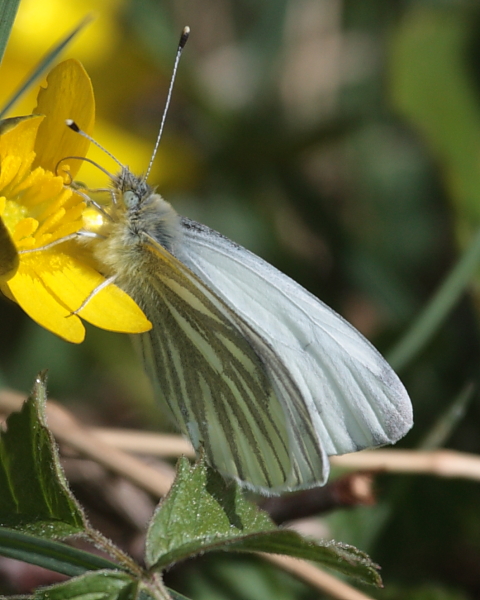
I ran my 15W Heath Trap overnight (min. temp. 2 Celsius) at Holt Copse and caught:
Nothing! I think this is the first time this has happened.
Monday 2nd April [Sunny and warm, though cloud is building]
I went down early to check the moth trap and there had apparently been a hard frost overnight. Consequently, there was lots of mist rising from the water and it wasn't until about 0800hrs that it started to clear. I carried out my annual April bird survey checking for singing migrants (and residents) this morning, before the weather takes a turn for the worse. The Winter Wren count was high, as you'd probably expect after our mild winter. Numbers seem to be as good as ever they've been with the exception of Willow Warbler Phylloscopus trochilus which seems to be late arriving.
Other sightings this morning included the adult ♂ Greater Scaup Aythya marila off Butcombe Bank, the wintering Common Sandpiper Actitis hypoleucos on the dam wall, a pair of Common Kestrels Falco tinnunculus mating, a pair of Eurasian Teal Anas crecca at Rugmoor and some Eurasian Siskins Carduelis spinus at Hellfire Corner.
The warm weather has caused the bottom of the lake to start breaking away and float to the surface and while it looks unsightly, I understand it hasn't affected the fishing too much. It has even attracted a few Northern Shovelers Anas clypeata to feed out around the aerators.
This evening a ♂ Garganey Anas querquedula flew in to Top End, the first Spring record for quite a few years. Robert Billingsley emailed later to say he'd seen it at 1500 hrs near the dam before it swam towards the Lodge, so it appears to be quite mobile.
Tuesday 3rd April
Bristol Water are briefing that Blagdon Lake is 86% full (compared with 91% this time last year).
Wednesday 4th April [Our first rain showers for ages on a cold northerly wind]
I have been walking in the Cotswolds for the last two days and as soon as I got back to Blagdon this evening, being the obsessive that I am, I popped down just before dark and saw a flock of 30-50 hirundines in Butcombe Bay. There was at least 1 Barn Swallow Hirundo rustica and 2 House Martins Delichon urbicum among the flock of 30 or more Sand Martins Riparia riparia. The adult ♂ Greater Scaup Aythya marila was just off the dam wall with a few Tufted Ducks Aythya fuligula. haven't received any other news while I've been away. It was interesting to me that in the 32 miles or so that I walked from Northleach to Tetbury across the Cotswolds, I didn't hear a single Corn Bunting singing, though there were lots of Yellowhammers.
Thursday 5th April [A cold north-easterly wind]
I saw quite a few hirundines off the North Shore this morning with at least 4 House Martins Delichon urbicum among the flock, then at Rugmoor there was another, larger, flock containing good numbers of Barn Swallows Hirundo rustica. There also seemed to have been an arrival of Willow Warblers Phylloscopus trochilus overnight. The adult ♂ Greater Scaup Aythya marila was feeding close to the North Shore car park. When I got down to Top End I saw an Osprey Pandion haliaetus sitting in the dead tree opposite Top End hide. I went home for my camera, as an angler came and started to fish in front of the hide, and when I got back the bird had relocated to the 'cormorant sticks' at Hellfire Corner. Just as I got into position to take some photographs a couple of gulls started to dive-bomb it and it flew back towards the original tree at Top End. However, Murphy's Law being what it is, another angler had just walked all the way through the marginal vegetation from Rugmoor Point to fish under the tree! I haven't seen anyone fish there for the last decade...
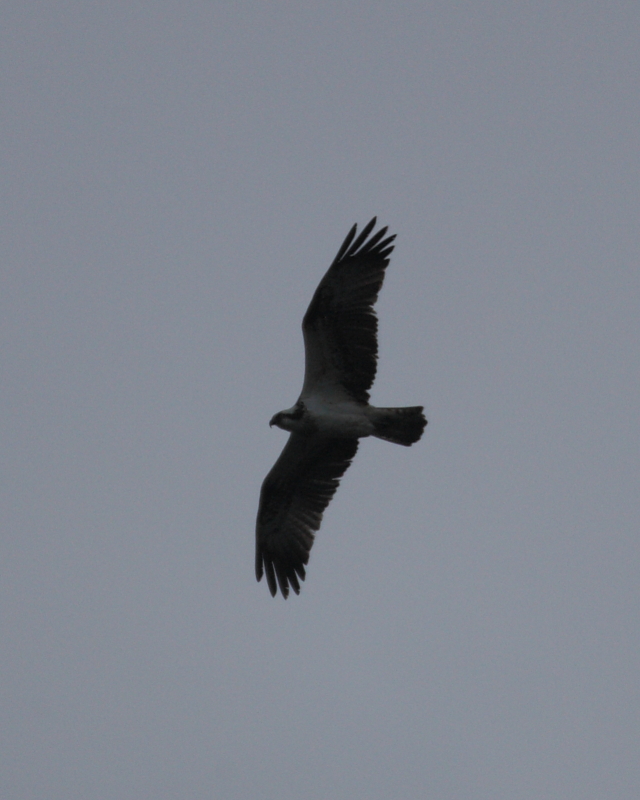
The Osprey was still present this evening sitting on the 'cormorant sticks' at 1930 hrs and may be roosting overnight. I have included a record shot taken in the murky conditions.
Friday 6th April [Cloudy, but the sun did poke through once or twice]
Quieter again this afternoon, with just the wintering Common Sandpiper Actitis hypoleucos on the dam wall and the adult ♂ Greater Scaup Aythya marila feeding close to the spillway of any real note. I saw 4 Eurasian Teal Anas crecca (one drake) towards Top End and a couple of adult Great Black-backed Gulls Larus marinus patrolling about the lake.
For those birdwatchers who have yet to add Ruddy Duck Oxyura jamaicensis to their year list, they'd better hurry up! British Birds has a news item this month stating that the government has found a further £200,000 to extend the cull and finish the job off. There are apparently less than 100 of the feral population remaining in the UK. So far, 7225 birds have been culled at a cost of £5 million. More info at https://secure.fera.defra.gov.uk/nonnativespecies/index.cfm?pageid=244
An email from Daniel Hargreaves contained some news: "Heidi and I took the dog down the North Shore (Butcombe Bank, my correction) last night and recorded all 3 pip species, noctules, myotis spp and serotine."
Saturday 7th April [Overcast but reasonably warm]
I carried out the WeBS Count this morning. I saw the adult ♂ Greater Scaup Aythya marila and Common Sandpiper Actitis hypoleucos but little else other than the usual species expected at this time of year. The numbers are on the WeBS Counts Page. There were 636 birds of 19 spp.
I was saddened to be subjected to shotguns being loosed off on Holt Farm, within five metres of where I was surveying, at Rooks Corvus frugilegus on a flight line to the Home Bay Rookery. There are young birds in nests which will no doubt be left to starve and die of the cold as a result. When I asked one of the young guys with a gun what he was shooting, he replied "crows"! Whilst it is perfectly legal (Schedule 2 part II of the W&CA 1981) for authorised persons to shoot Crows and Rooks, I can see no good reason to shoot Rooks that aren't even nesting on their land. Rooks eat many of the insect pests (especially while feeding young) that cause damage to their 'organic' crops. I have been monitoring the Home Bay Rookery (and others in ST45 and ST55) for the BTO and can confirm that this rookery is dwindling year-on-year. When I counted in March, there were fewer than a third of the nests I counted a few years ago. Apart from the corvids, the gunners were disturbing all manner of other wildlife, including the wildfowl I was trying to count.
I ran my 15W Heath Trap overnight (min. temp. 7 Celsius) at Hellfire Corner and caught:
- 2187 Common Quaker Orthosia cerasi 1
- 2188 Clouded Drab Orthosia incerta 1
- 2258 Chestnut Conistra vaccinii 1
Sunday 8th April [Warm with occasional sunny spells]
The ♂ Greater Scaup Aythya marila and Common Sandpiper Actitis hypoleucos were both still present this morning but I didn't see any other interesting birds in my 3 hour stint - I didn't even hear a Willow Warbler Phylloscopus trochilus, they seem to have moved on already.
I have added a new fish species to the list today. I spotted some Three-spined Sticklebacks Gasterosteus aculeatus in the feeder stream in Holt Copse including breeding males with their red throats.
The guns were out on Holt Farm again today. Pigeon sp. were in the firing line as well as corvids and were being attracted down by decoys placed in front of a blind.
Monday 9th April [Rain most of the day]
With the rain falling most of the day (and we certainly need it), there was a small influx of hirundines over the dam end of the lake with all three breeding species well represented. It was a miserable walk looking for migrant passerines and surprise surprise, I didn't find anything new. The ♂ Greater Scaup Aythya marila was still off the dam by the spillway. I didn't spot the Common Sandpiper, but by the time I looked, I'd had enough and didn't expend too much effort in the search!
We've seen Common Frogs Rana temporaria hopping about on the neighbours drive this afternoon. I guess they must be really enjoying the downpour. I expect there'll be a lot of Frogs and Common Toads Bufo bufo on the roads this evening, as they leave the ponds and lakes and make their way to the gardens, hedges and woods after spawning.
Tuesday 10th April [Sunny spells]
I was just going down to the lake when I got a call to say there was a ♂ Black-winged Stilt Himantopus himantopus found by Roger Palmer in front of Stratford Hide at Chew Valley Lake. So, I popped over there to take some pictures (see Recent Images Gallery). The light angle was difficult but it should improve this afternoon as the sun swings around. I checked for the ♂ Greater Scaup Aythya marila at Blagdon Lake on the way back and found it close in to the dam as usual. Later on this afternoon, I saw a handful of hirundines at Top End, Barn Swallows Hirundo rustica and Sand Martins Riparia riparia, there was also a pair of Eurasian Teal Anas crecca there too. Otherwise it was very quiet in the strong WSW breeze.

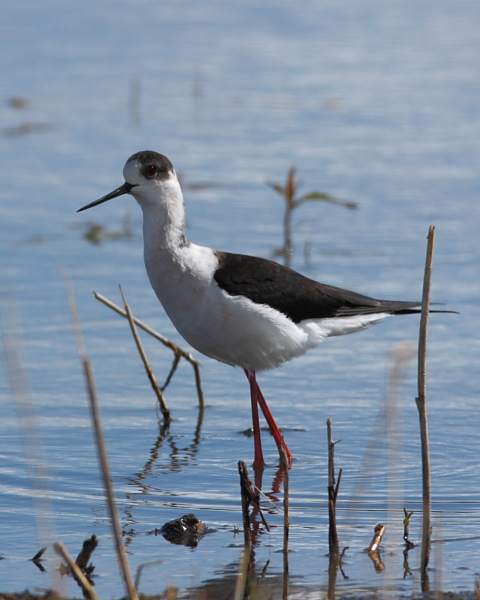
I've learned this evening, that the moth I've always known as Burnished Brass Diachrysia chrysitis with two forms, f. aurea and f. juncta, both of which we've recorded at the lake, has been split into two species. D. c. f. juncta with the dark bar across the centre of the wing split by brass colour has been renamed Cryptic Burnished Brass Diachrysia stenochrysitis. Armchair tick!!
Wednesday 11th April [Sunny spells and showers]
With the early 'negative news' report from Chew, I thought I'd better just check Blagdon before I went off to 'my other patch', Ubley Warren, to do some dry stone walling. Sadly, all I saw of note was the ♂ Greater Scaup Aythya marila off the dam, two very late Common Gulls Larus canus and an adult Peregrine Falco peregrinus sunning itself at Long Bay. This evening I saw the Common Sandpiper Actitis hypoleucos over at Never Never Land, so it's still around and Mark Chamberlain saw a Common Snipe Gallinago gallinago fly behind me at Holt Bay while I was chatting to him. There were Roe Deer Capreolus capreolus barking this evening. I wouldn't normally expect to hear them until the rut in late summer and autumn, but apparently both sexes may give warning calls at any time of the year. Ramsons Allium ursinum have come into flower at Hellfire Corner today.
Hilary Raeburn wrote to say she'd seen 4 Orange-tips Anthocharis cardamines in the area near the Top End bird hide and also at Flower Corner in the 'nectiforous' ditches just before an incredible downpour. All have been males.
Thursday 12th April [Sunny with rain at dusk]
The ♂ Greater Scaup Aythya marila was by the Spillway for most of the day and there were signs of migration with our wintering Common Sandpiper Actitis hypoleucos joined by another on the dam (well spotted Merv) and 3 Common Goldeneyes Bucephala clangula in Pipe Bay, which were new in, and presumably on their way North. I saw my first Holly Blue Celastrina argiolus of the year at Hellfire Corner and the first Mute Swan Cygnus olor was nesting lakeside at Flower Corner.
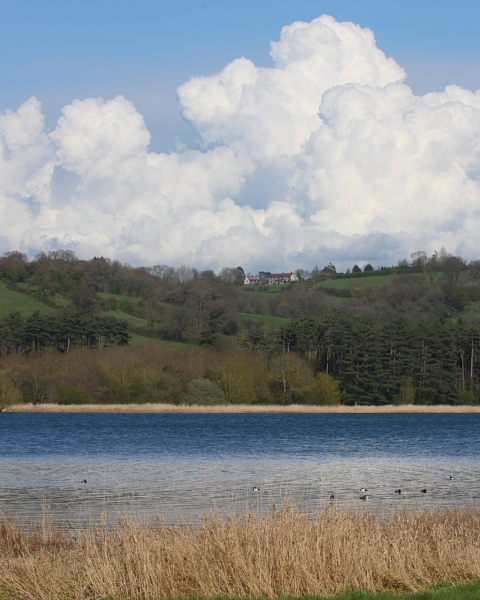
Friday 13th April [Sunny until steady rain set in this evening]
No sign of the ♂ Greater Scaup Aythya marila today, but Mervyn Pearce saw 3 Common Sandpipers Actitis hypoleucos on the dam mid-afternoon.
My two hour walk in the gentle, but steady, rain this evening was quite pleasant, though I only saw 2 Common Sands. The olfactory sense was sharpened and as I walked through Lodge Copse I picked up the very distinctive scent of Red Fox Vulpes vulpes and the heady perfumes of the flowering trees at Top End. In the last couple of days I've noted an Oak Quercus sp. coming into leaf, though most aren't yet. However, there's no sign of any Ash Fraxinus excelsior coming into leaf yet, though they are in flower. So it's probably a bit early to draw any conclusions based on the old rhyme:
Oak before ash we're in for a splash,
Ash before oak we're in for a soak.
There's some interesting historical information about the rhyme and a modern interpretation of the trigger for leaf opening at http://www.naturescalendar.org.uk/findings/spring/oakandash.htm I don't remember seeing Ash leaf first in the last few years and, if the science is right, I won't any time in the near future. The latest Bristol Water briefing on 10th April gives Blagdon Lake as 87% full (90% this time last year).
The British Birds Records Committee (BBRC) has accepted last years Long-billed Dowitchers Limnodromus scolopaceus, so congratulations to Merv Pearce, Rich Mielcarek and Keith Vinicombe. They have also accepted the Sharp-tailed Sandpiper Calidris acuminata as the 31st for Britain.
Saturday 14th April [Threatening early on but a pleasant, if cool, afternoon]
At last, it looked like spring had arrived at the lake this afternoon. There were several hundred hirundines over the water and Mark Chamberlain told me he'd seen and heard about 7 Common Swifts Apus apus screaming around the Lodge this morning. This is the earliest date Swift has been recorded at the lake according to my records and I eventually saw 2 over Green Lawn at around 1630 hrs, but the real excitement was the appearance of the 3rd Osprey Pandion haliaetus of the spring. It flew in from the south-west at 1450 hrs and, after looking hopefully for a fish over Orchard Bay / Ash Tree, flew towards Top End and spent some time hovering over the water from Burmah Road to Bell's Bush before seeming to fly off east towards Chew at 1500 hrs. There was a ♀ Common Goldeneye Bucephalus clangula diving over by The Spinney, perhaps the last of the winter visitors still hanging on. The strong north-east breeze was pushing waves up the dam wall and I couldn't see any Common Sandpipers Actitis hypoleucos there this afternoon. Here's another Osprey record shot, from today:
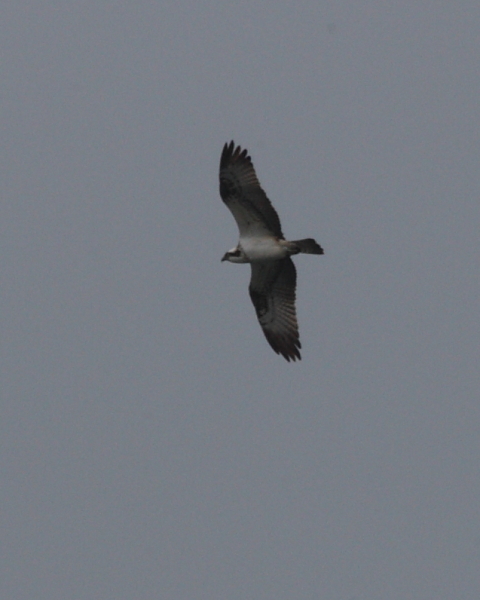
Sunday 15th April [Sunny intervals with a keen northerly wind]
There were plenty of hirundines at Top End again, but no sign of any Common Swifts Apus apus while I was there. Curiously, at least one Sand Martin Riparia riparia landed on the tarmac at Burmah Road several times despite the steady fisheries traffic. Could it have been to warm up? See picture. I did note the first Mallard Anas platyrhynchos brood of mum and 8 very young ducklings and was pleased to see one of the Ubley Hatchery Common Kingfishers Alcedo atthis alive and well.
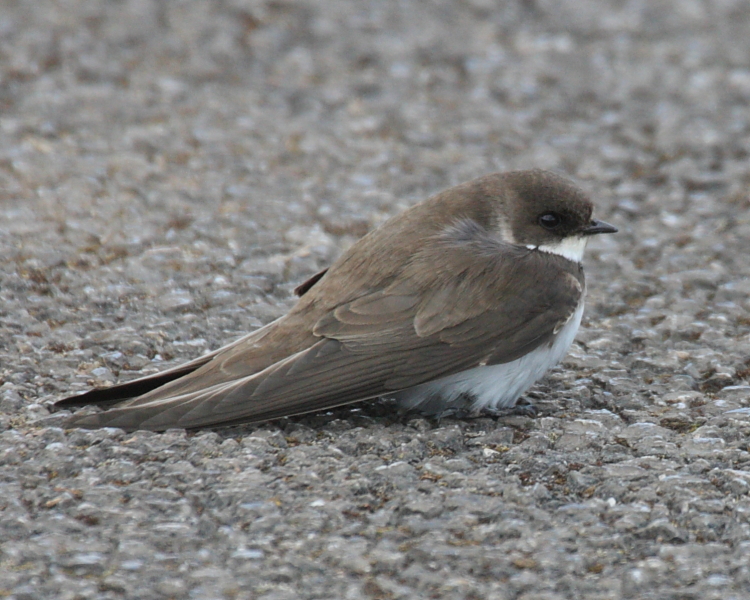
I also saw my first couple of ♂ Orange-tips Anthocharis cardamines and a Violet Oil Beetle Meloe violaceus for the first time for several years beside the lake. I've recorded it in the past at Hellfire Corner and look for it most years, but this one was at Flower Corner in the west ditch. Oil beetles are fascinating creatures with females that lay eggs in the soil. Larvae, after hatching out, climb into flowers and wait until a solitary bee comes along then attach themselves to it in order to be taken back to the nest where they feed on the bee's eggs and food provisions. I spent a happy afternoon several years ago at Cardiff Museum going through their specimens with a key, so am confident enough about identifying todays specimen from a couple of photos I grabbed as it crawled through the grass.
This evenings visit was a mixture of good and bad news; good news was the first Sedge Warbler Acrocephalus schoenobaenus singing and showing nicely at Ash Tree close to, and here's the bad news, a Mute Swan Cygnus olor corpse bearing a ring which I will get checked. Sadly, I saw a flattened road casualty Sand Martin where I photographed one this afternoon (I watched that one fly off over the lake, but it or another must have come back).
I ran my 15W Heath Trap overnight (min. temp. 1 Celsius) at Lodge Copse and caught:
Nothing!
Monday 16th April [Sunny with a variable light breeze]
I spent 3 hours lakeside this morning counting singing birds but saw nothing worthy of note, either on the water or off. Pick of the count were 57 Winter Wrens Troglodytes troglodytes, an amazing 35 Blackcaps Sylvia atricapilla and 8 Reed Buntings Emberiza schoeniclus. There was no sign of last nights Sedge Warbler Acrocephalus schoenobaenus. Paul Williams told me he'd seen the Mallard Anas platyrhynchos brood in front of Top End hide today and counted 10 juveniles.
As the sun is shining, I'll go back this afternoon and photograph Early Purple Orchids Orchis mascula some of which have been in flower for a few days. The weather forecast for the rest of the week is a bit miserable, so I might as well make the most of it.
**THEFT**
I drove the 8 miles, or so, to the North Shore with all my gear to photograph a particularly nice clump of Early Purple Orchids this afternoon, as it was too dark to get a decent shot yesterday evening, and someone has seen fit to dig them out of the bank by the track and steal them! What kind of mindless idiot does these things? It is an offence to dig up wild flowers and the more so as the meadows are SSSI status. There is information on picking and uprooting wild flowers at http://www.thewildflowersociety.com/wfs_new_pages/1f_code_of_conduct.htm So, sorry dear reader, there's no picture to whet your appetite, just a hole in the roadside bank with two heel marks and a pile of earth on the track!
Tuesday 17th April [A bit wild with sunshine and showers]
The 1st-summer ♀ Long-tailed Duck Clangula hyemalis is back from Chew Valley Lake and was showing very well from the corner of dam at Cheddar Water, until I went to get my camera! It has certainly darkened in plumage having just undergone a moult of head and possibly the body. There's a couple of pictures in the Recent Images Gallery. If you can't see it from the dam, try Pipe Bay. I heard, but didn't see, Eurasian Reed Warbler(s) Acrocephalus scirpaceus singing in Home Bay reeds for the first time this year and while I was trying to photograph the Long-tailed Duck in the rain this afternoon, I heard a commotion from the Eurasian Kestrels Falco tinnunculus in the grounds of the Pumping Station and saw them mating.

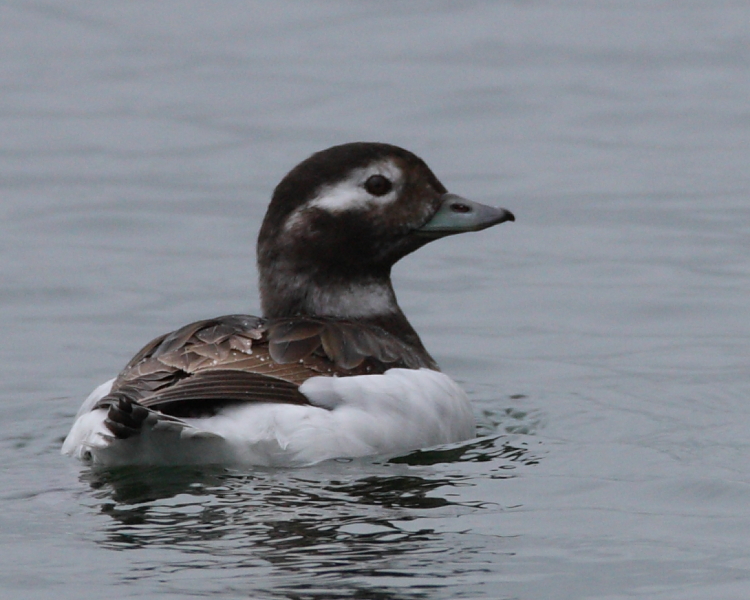
Wednesday 18th April [Lots of showers and quite cool]
There was no sign of the ♀ Long-tailed Duck Clangula hyemalis which was reported to be back at Chew Valley Lake today. I walked the south shore this afternoon and saw lots of hirundines over both the Dam End and the Top End. Just what they are finding to eat is difficult to understand because the midge hatches seem to have all but stopped over the last few days. Even the anglers have noticed the lack of fly life. Willow Warblers Phylloscopus trochilus are still singing after a few days at the Top End hide and Hellfire Corner. It'll be interesting to see if they stick around, or move on like most do.
Thursday 19th April [Squalls and still cool]
Highlight of my four hour visit was another Osprey Pandion haliaetus which flew through from the east at 1220 hrs. I was chatting at Peg's Point when it came around Rugmoor Point at about 100 feet above the water and just kept flying west just off the north shore and out of sight behind Ash Tree copse. It was really hard to pick out any underwing and body detail because we were looking towards the brightest part of the sky. I assume it left to the west or north-west, but it may have landed further up the lake at Butcombe Shore in the wet conditions. I saw the ♀ Common Goldeneye Bucephala clangula in Butcome Bay asleep with a group of Tufties Aythya fuligula and heard a Sedge Warbler Acrocephalus schoenobaenus singing on the North Shore. It sounds like a few more Eurasian Reed Warblers Acrocephalus scirpaceus have arrived and started singing in the reed beds, but they're keeping their heads down in the windy conditions. Hilary Raeburn told me she'd seen one in Home Bay. The Eurasian Kestrels Falco tinnunculus were mating again in the Pumping Station grounds as I walked over the dam and I saw two more Mallard Anas platyrhynchos broods, a female with 7 young at Spinney Point and another with 3 young at Top End, bringing our total to three broods so far this year. Finally, I found my first Adder's-tongue Ferns Ophioglossum vulgatum of the year as well.
Having chatted to a few anglers this morning on my round, they tell me there are lots of small green midges and some larger black buzzers hatching despite the cool conditions, so this should help feed the migrant hirundines, numbers of which seemed to be down today.
Friday 20th April [Sunshine and showers]
I'm tempted to say the most exciting thing about my visit today was the weather! I managed to dodge the showers and saw a couple of Common Swifts Apus apus with hirundines feeding over Top End. There really are very few birds on the water now, just a few groups of Tufted Ducks Aythya fuligula in the main, one of which was joined by a ♀ Common Pochard Aythya ferina today (yes, it's that bad). The Common Coots Fulica atra are nesting in many places and I saw my first predated egg at Hellfire Corner, probably a victim of the Carrion Crows Corvus corone, and I heard a Little Grebe Tachybaptus ruficollis trilling at Top End where I also saw a Speckled Wood Pararge aegeria butterfly on the wing between the showers, the first since 29th March.
Tonight, Daniel Hargreaves is giving an interim report to YACWAG on last years bat monitoring and will announce plans for increased monitoring this year, including a trapping session proposed for tomorrow night (weather permitting).
Saturday 21st April [More sunshine and showers]
As with Chew today (per Sean Davies, Bristol Wildlife), there has been an arrival of Common Sandpipers Actitis hypoleucos overnight. I counted 8 on the dam late morning. There were also a few more Willow Warblers Phylloscopus trochilus singing in various places and a Sedge Warbler Acrocephalus schoenobaenus singing in the roadside hedge about 100 metres east of Top End Hide car park.
Mervyn Pearce rang just before 1700 hrs to tell me he'd just counted 9 Common Sandpipers Actitis hypoleucos on the dam!
There will be a bat trapping session tonight, meeting at 1900 hrs on the dam. One of the principal aims is to find out more about the Nathusius' Pipistrelle Pipistrellus nathusii at Blagdon Lake, as part of a 3 - 5 year project co-ordinated by Daniel Hargreaves and the Yatton & Congresbury Wildlife Action Group (YACWAG) team.
We ran 2 Harp traps and a mist net on Butcombe Bank from 2100 - 0130 hrs and caught:
- Daubenton's Bat Myotis daubentonii 1♀ [pregnant]
- Whiskered Bat Myotis mystacinus 1♂
- Soprano Pipistrelle Pipistrellus pygmaeus 6
- Nathusius' Pipistrelle Pipistrellus nathusii 1♂ [the 18th ringed by Daniel at BL]


I also ran my 15W Heath Trap (min. temp. 8 Celsius) in the wood on Butcombe Bank for the same period and caught:
- Brindled Pug Eupithecia abbreviata [first site record] 1
The biggest surprise of the evening for me was Daniel spotting a glowing Glow-worm Lampyris noctiluca on the path. I went to have a look at it and eventually found a larva glowing weakly which I photographed.
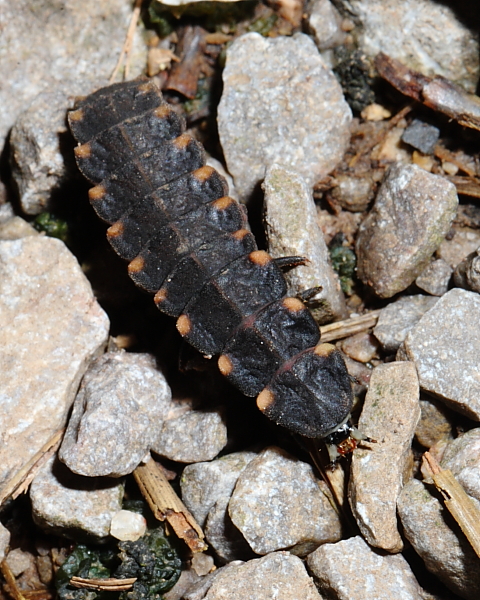
Sunday 22nd April [Windswept with showers]
I saw at least 3 Common Sandpipers Actitis hypoleucos on the dam and Ian White saw one at Orchard Bay where he found a ♂ Common Whitethroat Sylvia communis singing - possibly the one that turned up there last year as well?
Monday 23rd April [Wet and windy]
There were 3 Common Sandpipers Actitis hypoleucos on the cill of the Spillway / Byewash making the best of feeding between the waves crashing up against it in the ENE wind. I saw 2 over at North Shore as well, but assume that these were probably the same. I caught up with the ♂ Common Whitethroat Sylvia communis over at Orchard Bay (thanks for the tip-off Ian), and saw 2 ♂ Gadwall Anas strepera and 3 Common Swifts Apus apus along with all the common hirundine species at Top End. So, much the same fare as yesterday.
I received the Spring 2012 WeBS News from the BTO today, in which there is an article titled "Worrying signs for many of Europes seaducks". There have been 18 records of Long-tailed Duck Clangula hyemalis at Blagdon, so far as I can tell, and we have been privileged to have had the immature ♀ spend this winter here and at Chew. However, future occurrences may start to take on something of a draw for local twitchers if the news in the report is true. According to a recent project carried out in the Baltic Sea (SOWBAS) the number of Long-tailed Ducks has declined by a staggering 65% between 1992-93 and 2007-09; the equivalent of 1.8 million birds. Large declines of 42-51% were also found for Common Eider Somateria mollissima and Red-breasted Merganser Mergus serrator. The article continues by saying declines are also being recorded in UK waters, in particular Long-tailed Duck and Velvet Scoter at their key site, the Moray Firth, where Velvet Scoter Melanitta fusca numbers are down from several thousand birds to less than 100 in less than a decade and Long-tailed Ducks have declined from >10,000 to to fewer than 1000 in recent winters. Red-breasted Merganser numbers are down by 34% nationally over the past decade too. The author suggests that, although we can probably assume some species e.g. Common Goldeneye Bucephala clangula are short-stopping on their migrations, the trends are probably representative of what is happening to the whole European population of the four species cited, as there is no evidence forthcoming to suggest they are wintering elsewhere. More info at www.wetlands.org where there are some other very interesting papers on wildfowl, including 'A guide to ageing and sexing North American ducks.' Will I ever be lucky enough to see a Velvet Scoter or Common Eider at Blagdon, I wonder?
Tuesday 24th April [Rather pleasant with the occasional shower]
The 2 Common Sandpipers Actitis hypoleucos I saw late morning on the dam had swelled to 6 by early afternoon and Paul Williams reported seeing the ♀ Common Goldeneye Bucephala clangula towards Top End. Otherwise, it's still quiet on the migrant front. No terns dropped in with the showers around midday.
This evening I went back to photograph a couple of bracket fungi I spotted while moth and bat trapping on Saturday evening. They appear to be the wonderful Dryad's Saddle Polyporus squamosus also known as Pheasant's Back - see photo. I also saw the very distinctive hoverfly Leucozona lucorum on the wing.
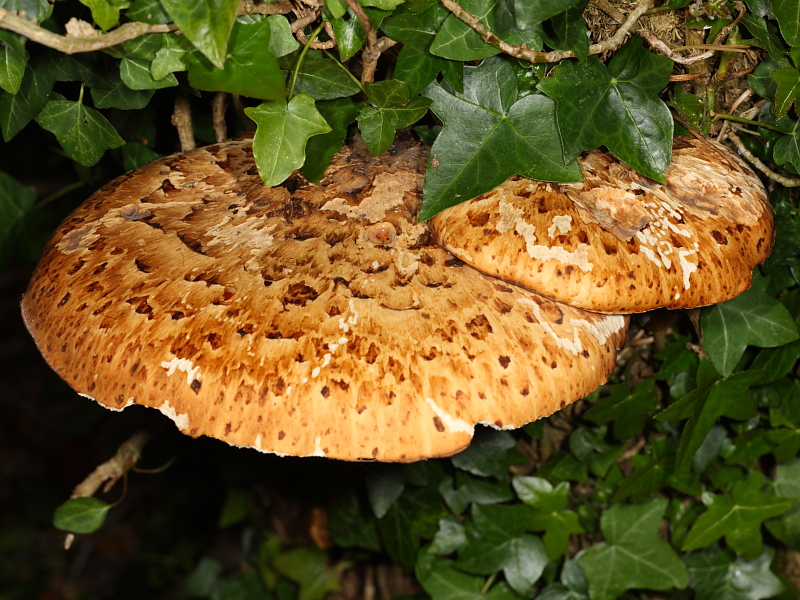
Wednesday 25th April [Wet, wet wet!]
I know I should have visited this morning to look for terns, but I went to Middle Hope with Alan Bone for a coastal walk instead and amazingly dodged all the showers. We saw a ♂ Northern Wheatear Oenanthe oenanthe and 2 Whimbrel Numenius phaeopus that flew up the coast past us calling as they went. When I got back I popped down to the lake before tea and saw a Common Tern Sterna hirundo which flew off soon after. Despite scoping the dam, the easterly wind and waves meant there were no Common Sandpipers there in conditions that would have better suited Sanderling!
Thursday 26th April [Showers and a bit milder]
Divers are still working at the dam, but I did see 4 Common Sandpipers Actitis hypoleucos at Cheddar Water first thing this morning, before I went to a Somerset Wildlife Trust meeting. This afternoon I saw a Common Tern Sterna hirundo over the dam end and a large group of hirundines at the Top End contained at least 20 Common Swifts Apus apus. There was also a Sedge Warbler Acrocephalus schoenobaenus singing in the hedge at Wood Bay.
The lake is 94% full (87% this time last year) on 24th April according to the latest Bristol Water briefing, but with the recent rain, it looks like we will be at top level in the next couple of days if the inflow continues. This is great news for the water company, considering the Environment Agency declared the south-west, including Bristol and Somerset, as being officially in drought as of 16th April. How this state of affairs will reflect on the water level for autumn migration we will have to wait and see. But, what it has meant is that some of the Common Coot Fulica atra nests have been flooded due to the combination of rising water and waves from all directions on variable winds. Others are sitting high and proud on large mounds well away from marginal vegetation that would normally provide some cover, so whether they will survive the attentions of aerial predators, or not, we shall have to wait and see.
Friday 27th April [Rain and more rain]
I was out walking most of the day but did get down to see 2+ Common Sandpipers Actitis hypoleucos on the dam. While I was looking at the dam I noticed that the water is now lapping the top of the cill of the Spillway and will almost certainly be flowing over this weekend, possibly even as early as tomorrow morning.
Saturday 28th April [Mainly dry but very windy]
It was a strange afternoon down at the lake. I met a fisherman who told me he'd seen a Reeves' Muntjac Muntiacus reevesi which, if confirmed, would be the first record so far as I'm aware. They have spread to this region so it is quite possible, though Roe Deer Capreolus capreolus is far more likely. Then there were two more, potentially sinister, developments to be investigated that may be linked to wildlife crime.
On a brighter note, there were thousands of hirundines, mainly Barn Swallows Hirundo rustica, and a few Common Swifts Apus apus over the lake and surrounding fields today which inevitably attracted the first Eurasian Hobby Falco subbuteo of the year. More Common Coot Fulica atra nests have been washed out in the strong winds and rising water over the last 24-48 hrs and the Mute Swans Cygnus olor at Flower Corner are busily trying to keep even their great mound of a nest above the waterline.
Sunday 29th April [Cold, wet and windy]
What an absolutely miserable day! The lake has reached top level, but the bad news is that virtually all the Common Coot Fulica atra nests have been washed out and the Mute Swans Cygnus olor that nested at Flower Corner also appear to have abandoned. I spent an hour at the lake either side of lunch and there were thousands of hirundines over the water and surrounding meadows, but no sign of any terns. This evening, I walked the south shore road and spotted an adult ♂ Garganey Anas querquedula at Top End.
If any birders plan to visit in the next day or two, be aware you'll need walking boots at the very least to get along the south shore road which is flooded in places. The barriers were also closed this afternoon to prevent anyone driving off the flooded road into a ditch.
Monday 30th April [Some showers and much milder]
Hilary Raeburn saw 3 Common Sandpipers Actitis hypoleucos at the dam end this afternoon and I saw a flyover Whimbrel Numenius phaeopus this evening and circa 40 Common Swifts Apus apus gathered at dusk over Holt Copse. There was also a Tawny Owl Strix aluco silhouetted in a Scot's Pine Pinus sylvestris surveying all.
We continue to have Eurasian Siskins Carduelis spinus visiting the garden feeders and I watched 2♂♂s on them this morning.